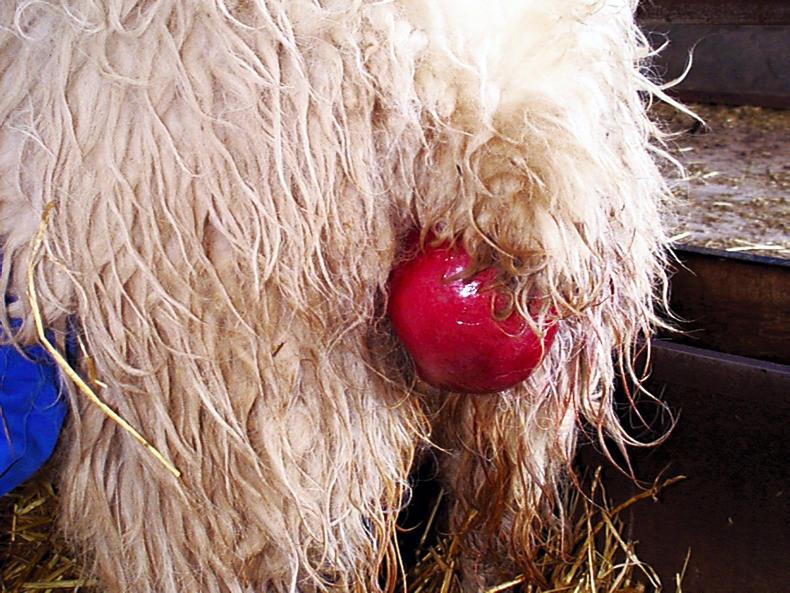Cause
There are several predisposing factors. Feeding bulky forage such as silage which take up a large volume in the abdomen is considered one of the most significant risk factors. The distended rumen in conjunction with the growing lamb(s) push the vagina out. It is most commonly seen in association with multiple lambs and overfat ewes. Other factors implicated include tails that have been docked too short, excessive coughing or ewes lying on steep ground. Other causes stem from hereditary factors and previous lambing difficulties.
As nutrition is thought to be a big factor in vaginal prolapses it has been suggested (along with many other theories) that if poor-quality feeds are provided the ewe will have increased rumen fill in order to meet energy demands. The result is that the vagina is pushed out due to the increased pressure in the abdomen. Poor nutrition is also said to cause slackness of the ligaments around the birth canal.
Symptoms
Vaginal prolapse begins as the cervix or vagina peeping out as a pink surface through the vulva when the ewe is lying. This can progress slowly or rapidly to a complete prolapse where the whole vagina is everted. This can interfere with urination and the sheep can become acutely ill as a result. Other possible consequences include damage to the vagina due to injury or vaginal rupture which is rapidly fatal.
Treatment
Individual cases can be left for long periods without treatment if the cervix “peeps out” intermittently and only mild trauma occurs. This can lead to early abortion of non-viable lambs due to premature rupture of the cervical seal and infection gaining access to the womb. If this is seen, it is worth treating as soon as possible.
There is little doubt that replacement of the prolapse after administration of an epidural injection to prevent forcing is the best way to rectify this problem. The prolapse should be cleaned before returning it to its correct position. The epidural also gives pain relief and allows easy stitching of the vulval lips together which prevents the prolapse from recurring. Administration of pain relief products helps to alleviate forcing in individual cases which are problematic or cases which reoccur. To replace many prolapses, the bladder must be emptied firstly and trying to replace it without knowing how to empty it can result in bladder rupture and death two to three days later. Penicillin-based antibiotics should always be administered to these cases as gangrene of the vagina is a real risk. Once the prolapse has been successfully replaced it is important to observe the ewe closely for impending lambing. If the prolapse is damaged, it is important to consult your vet as soon as possible as these cases can die rapidly.
Prevention and control
An important fact to mention is that prolapse cases often become repeat offenders so it is useful to mark affected sheep and cull them at the end of lactation. Avoid breeding from offenders’ offspring as there may be a hereditary input to this disease. As nutrition is one of the largest contributing factors, the use of ultrasound scanning earlier in pregnancy to identify multiple births is highly recommended. It can be used to predict accurately the ewes carrying multiples. This allows accurate feed allocation. High dry matter (hay) and energy dense feeds (concentrates) should be fed to such ewes to ensure they are being fed to meet their nutritional needs, in a manner that does not distend the rumen.






 This is a subscriber-only article
This is a subscriber-only article









SHARING OPTIONS: